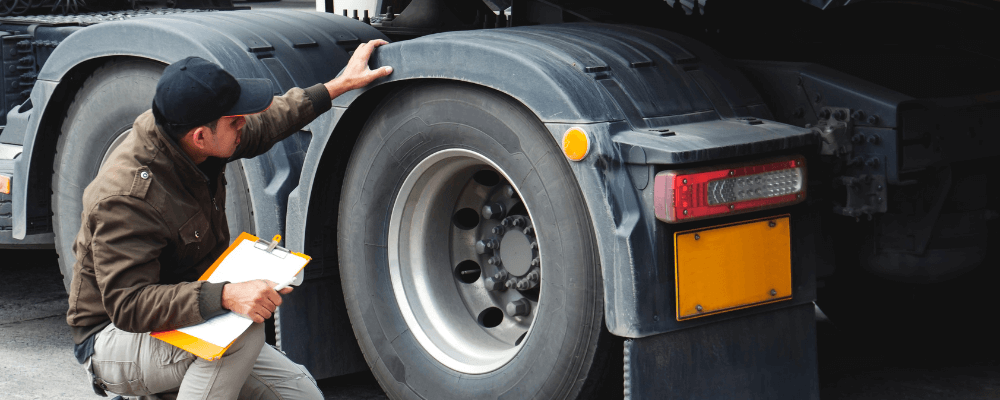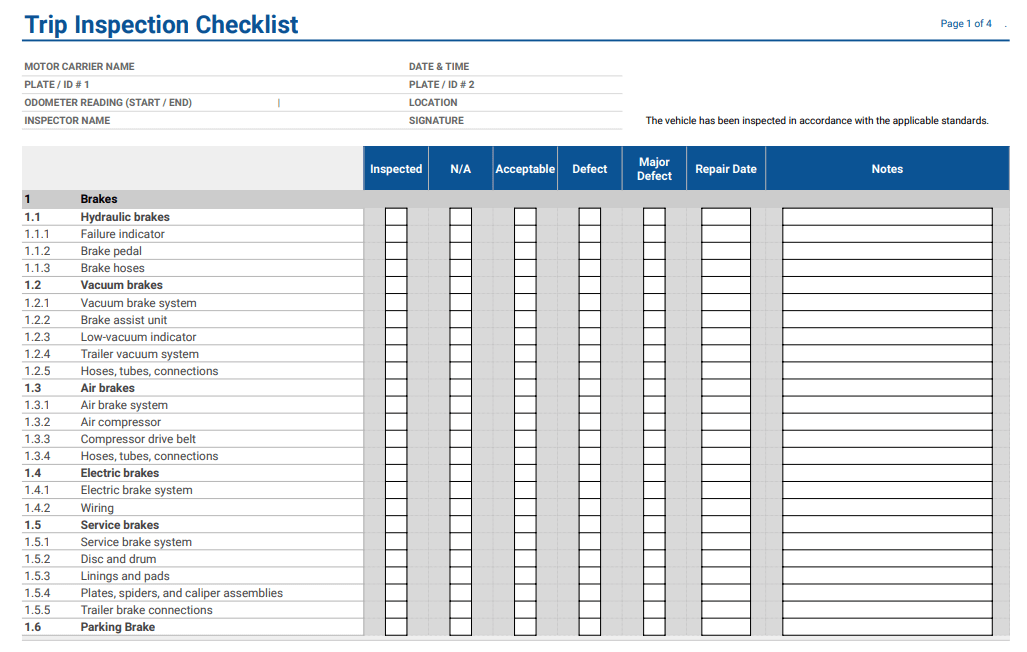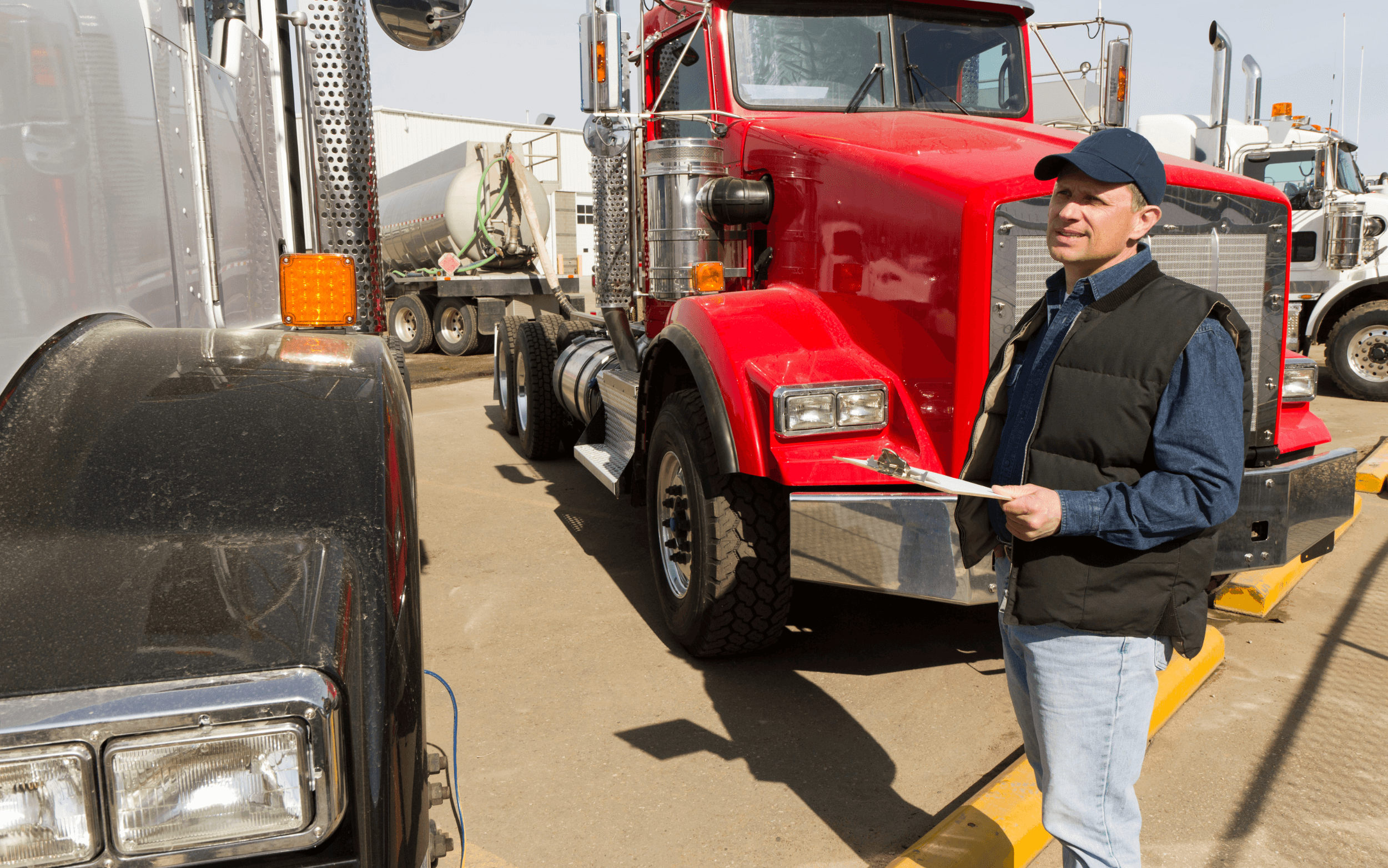I’m going to tell you something you already know: safety and compliance are non-negotiable in your industry. Truck trip inspections are not just routine—they’re essential. Mandated by the Department of Transportation (DOT) and Federal Motor Carrier Safety Administration (FMCSA) in the United States and the Canadian Council of Motor Transport Administrators (CCMTA) in Canada, these inspections are designed to catch potential issues before they could lead to breakdowns, fines, or worse—accidents on the road.
Whether you’re a safety manager or a worker responsible for ensuring the job site vehicles are in safe operating condition, your role is crucial in preventing accidents and maintaining regulatory compliance. One of the key responsibilities in this process is conducting thorough truck inspections and preparing a driver vehicle inspection report (DVIR)—before and after every journey.
In this comprehensive guide, I’ll walk you through everything you need to know about pre- and post- trip inspections and DVIRs, from understanding the legal requirements to implementing best practices that make the inspection process and document management more efficient and reliable.
Read on or skip ahead to one of these sections:
What is a Truck Trip Inspection
Are Pre- and Post-Trip Inspections a Requirement?
What is a Driver Vehicle Inspection Report (DVIR)?
Who is Responsible for Conducting Inspections?
How Long Do Pre- and Post-Trip Inspections Take?
Key Elements of a Pre-Trip Inspection
5 Best Practices for Trip Inspections
Top 10 Defects Found During Pre- and Post-Trip Inspections
Fines for Violating Trip Inspection and DVIR Requirements
What is a Truck Trip Inspection?
Pre- and post-trip inspections are checks performed before and after the vehicle hits the road. The primary goal of truck trip inspections is to prevent accidents and breakdowns, which can lead to costly delays, fines, injuries, or worse.
A thorough inspection covers these parts and accessories as a minimum: Brakes, steering mechanism, lighting devices and reflectors, tires, horn, windshield wipers, mirrors, coupling devices, wheels and rims, and emergency equipment.
Are Pre- and Post-Trip Inspections a Requirement?
While pre- and post-trip inspections are essential for identifying potential safety hazards, they are also mandatory to ensure compliance with regulatory standards set by the Federal Motor Carrier Safety Administration (FMCSA) in the United States and the Canadian Council of Motor Transport Administrators (CCMTA) in Canada.
- United States: Code of Federal Regulations (CFR) 396.11 & CFR 396.13
- Canada: National Safety Code (NSC) Standard 13
The CCMTA has strict regulations that require documented inspections. Failing to conduct these inspections—or failing to produce the necessary documentation—can result in hefty fines, legal liabilities, and even the suspension of your vehicle’s operation. Trip inspections must be produced upon demand, and be no more than 24 hours old.
The FMCSA requires that the inspections be carried out, but documentation (in the form of a DVIR) is only required if a safety-related defect is found. However, documenting the inspection process and retaining proof is a highly recommended practice (and required if crossing the northern border into Canada).
What is a Driver Vehicle Inspection Report (DVIR)?
The DVIR is a formal document where the results of the vehicle inspections are recorded. It serves as a record that the inspection was completed and identifies any issues found during the inspection.
The DVIR is about documentation and compliance. It ensures there is a record of the vehicle’s condition, helps track maintenance needs, and provides evidence that the company is complying with regulatory requirements. There are also rules around retention of the original documents— 3 months from the date of the initial report for the FMCSA and 6 months for the CCMTA.
As stated in the previous section, a DVIR is only required in the US if the driver is aware of a safety-related defect. Canadian carriers operating in the US may elect to follow either the US or Canadian regulations around reporting.
Who is Responsible for Conducting Inspections?
In most construction settings, the responsibility for truck trip inspections falls on the shoulders of the safety officers and the workers who operate or oversee the vehicles. Safety officers are tasked with ensuring that all inspections are performed and documented according to the required standards, while the workers are responsible for actually conducting these inspections and reporting any issues.
Those carrying out the inspection are required to have certain qualifications, including:
- Training and/or experience as a mechanic or vehicle inspector
- Understanding of the inspection criteria and the tools used to perform the inspections
- The ability to identify defective components
Each member of the team plays a critical role in this process. Safety officers must provide the necessary tools and training, ensuring that inspections are thorough and accurate. Workers must diligently follow the inspection procedures and promptly report any concerns. When everyone understands their role and takes the inspection process seriously, the entire operation runs more smoothly, safely, and compliantly.

How Long Do Pre- and Post-Trip Inspections Take?
The duration of pre- and post-trip inspections can vary based on vehicle complexity and the thoroughness of the inspection process.
Pre-Trip Inspection: 15 to 30 minutes.
- For standard vehicles, a pre-trip inspection usually takes around 15 to 20 minutes. However, for more complex vehicles, such as those with specialized equipment, the inspection may take 30 to 50 minutes.
Post-Trip Inspection: 10 to 20 minutes.
- A post-trip inspection generally takes about 10 to 15 minutes for most vehicles. For larger or more complex setups, the inspection may extend to 20 minutes.
Both inspections are essential for maintaining vehicle safety and regulatory compliance, with the focus on conducting a thorough check rather than simply meeting a time limit.

Key Elements of a Pre-Trip Inspection
Before any vehicle hits the road, a thorough pre-trip inspection is critical. This inspection serves as the first line of defense against potential safety hazards and mechanical issues. By taking the time to carefully check each key component of the truck, you can help ensure that your vehicle is safe, compliant with regulations, and ready to perform its duties without interruption.
Highlights of a Pre-Trip Inspection Checklist
A comprehensive pre-trip inspection covers several critical areas of the vehicle, ensuring that every part is functioning correctly. While a detailed checklist is essential (and available for download), here are some key highlights to focus on:
General Information
- Plate or identification number(s) for the vehicle(s).
- Motor carrier’s name.
- Date and time of inspection, including where the inspection was performed.
- Odometer reading, if applicable.
- Signed statement by the person carrying out the inspection that the vehicle has been inspected in accordance with the standards.
Exterior Inspection
- Brakes: Test the brake system, including the service brake, air brakes, hydraulic brakes, etc. Make sure there are no audible air leaks (for air brake systems), and check that the brake pads are not excessively worn.
- Lights and Reflectors: Ensure that all lights (headlights, brake lights, turn signals) and reflectors are clean, properly aligned, and functioning. Faulty lights can lead to accidents, especially in low-visibility conditions.
- Tires and Wheels: Check the tire pressure, tread depth, and overall condition. Look for signs of wear, damage, or under-inflation. Also, inspect the wheels and rims for any cracks, bends, or other issues that could lead to a blowout.
Interior Inspection
- Steering and Horn: Test the steering wheel, horn, and other controls to ensure they are responsive and working as expected.
- Seat Belts: Inspect the seat belts for wear and tear, and ensure they buckle securely.
- Safety Equipment: Check that all required safety equipment is present and in good condition. This includes the fire extinguisher, emergency triangles, first aid kit, and any other equipment required by law or company policy.
Complex Systems
- Fuel System: Inspect the fuel tanks, lines, and caps for leaks, corrosion, or any signs of wear that could lead to fuel system failure.
- Suspension: Check the suspension system, including shocks, struts, leaf springs, and airbags, for damage or wear that could affect the vehicle’s stability and handling.
- Couplings and Hitches: For vehicles with trailers, inspect the couplings, hitches, and fifth wheel for secure attachment, proper lubrication, and any signs of damage or wear.
- Exhaust System: Examine the exhaust system, including pipes, mufflers, and catalytic converters, for leaks, rust, or damage that could impact vehicle emissions or driver safety.
- Electrical System: Inspect the battery, alternator, wiring, and connections to ensure that the electrical system is functioning correctly and that there are no exposed or damaged wires.
Download a Complete Pre-Trip Inspection Checklist
These are just a few of the essential areas to cover during a pre-trip inspection. To make sure you don’t miss anything, it’s crucial to use a detailed checklist. We’ve created comprehensive pre-trip inspection checklists that align with FMCSA and CCMTA standards, designed to help you streamline the inspection process and ensure full compliance.
This checklist is available for free download and will provide you with step-by-step guidance to keep your vehicles safe and road-ready. Download the Checklist Now.

Helpful Acronyms for Trip Inspections
To simplify trip inspections, several helpful acronyms can keep key checks top of mind.
- For anything mounted to the truck, remember PMS—everything should be Properly Mounted and Secure.
- When inspecting rubber components, use ABC to check for Abrasions, Bulges, or Cuts.
- For metal parts, think CBB—ensure they are not Cracked, Bent, or Broken.
5 Best Practices for Trip Inspections
- Training and Empowering Drivers:
- Provide comprehensive training to ensure all relevant staff are trained on how to perform detailed pre-trip and post-trip inspections correctly and understand the importance of these checks.
- Use Digital Tools for Inspections:
- Digital tools streamline the inspection process, enabling safety officers and drivers to complete and sign forms directly on their mobile devices. This reduces the risk of lost paperwork and ensures regulatory compliance. Digital platforms also allow for quick duplication of previous forms, saving time and maintaining consistency.
- Maintaining Compliance and Safety Records:
- Maintain detailed records of all inspections, including any issues found and actions taken. This documentation is invaluable for tracking maintenance needs and demonstrating compliance.
- Fostering a Safety-First Culture:
- Encourage a culture where safety is a priority by recognizing and rewarding thorough inspections and adherence to safety protocols.
- Consistency is Key:
- Perform inspections consistently, ideally at the same times each day, to develop a routine that becomes second nature for your team.
Top 10 Defects Found During Pre- and Post-Trip Inspections
Identifying and addressing common issues during pre- and post-trip inspections is crucial to maintaining vehicle safety and regulatory compliance. Below are the top 10 defects that safety officers and workers frequently encounter:
- Tire Underinflation:
- Low tire pressure is a frequent issue that can lead to tire failure, reduced fuel efficiency, and increased stopping distances. Regularly checking and maintaining proper tire pressure is essential for safe operation.
- Worn Tread on Tires:
- Tires with worn tread are more susceptible to skidding, hydroplaning, and blowouts, especially in wet or icy conditions. Monitoring tread depth and replacing tires as needed can prevent accidents.
- Faulty Brake Systems:
- Worn brake pads, low brake fluid levels, or air leaks in the brake system can significantly reduce braking performance. Ensuring brakes are in good condition before every trip is critical for safety.
- Non-Functioning Lights:
- Headlights, brake lights, turn signals, and other lights are vital for visibility and communication on the road. Regularly testing and replacing faulty bulbs prevents accidents and keeps vehicles compliant.
- Fluid Leaks (Oil, Coolant, Brake Fluid):
- Leaks from the engine, transmission, or brake system can lead to serious mechanical failures or fires. Inspecting the vehicle for fluid leaks and addressing them immediately is a key part of the inspection process.
- Battery Issues:
- A weak or corroded battery can cause starting problems and electrical failures. Checking battery health and cleaning terminals regularly ensures reliable vehicle operation.
- Suspension System Wear:
- Issues with the suspension system, such as worn-out shocks or broken leaf springs, can affect vehicle handling and stability. Regularly inspecting the suspension prevents these problems from worsening.
- Damaged or Missing Safety Equipment:
- Missing or damaged safety equipment like fire extinguishers, emergency triangles, and first aid kits can delay emergency response during a breakdown or accident. Ensure all safety equipment is present and in good condition.
- Cargo Securement Problems:
- Shifting or improperly secured cargo can lead to dangerous situations, including load spills or vehicle instability. Regularly check that all cargo is securely fastened before and after each trip.
- Undercarriage Damage:
- The undercarriage is often exposed to road debris, which can cause damage to the exhaust system, fuel lines, and other critical components. Inspecting the undercarriage for damage after each trip helps catch issues before they become serious.

Prevent Common Issues with Our Complete Inspection Checklist
Regular inspections can help prevent these common issues from becoming major problems. To ensure thorough and effective inspections, download our comprehensive Pre- and Post-Trip Inspection Checklist. It’s a free resource designed to help you cover all the necessary components and maintain safety and compliance. Download Here.
Fines for Violating Trip Inspection and DVIR Requirements
Fines can vary based on specific state/province regulations and the circumstances of the violation. However, here are some of the fines you could expect:
United States
Pre-Trip Inspection Violations: Range from $500 to $1,500 per instance. Repeated violations or severe safety issues can result in higher fines.
Driver Vehicle Inspection Report (DVIR) Violations: Range from $1,000 to $2,500 per violation. Penalties can be imposed for not documenting defects or not correcting them before operating the vehicle.
Canada
Pre- and Post-Trip Inspection Violations: Range from $500 to $1,000, depending on the province. The fine may be higher if safety issues are discovered during enforcement checks.
Driver Vehicle Inspection Report (DVIR) Violations: Range from $500 to $1,500. Penalties may increase if defects reported in the DVIR are not addressed, or if documentation is not maintained as required.
Conclusion
Pre- and post-trip inspections are vital practices that contribute significantly to the safety, efficiency, and longevity of your construction vehicles, including trucks, tractors, and trailers (intermodal equipment). By implementing thorough and consistent inspection routines with the help of technology, you can prevent accidents, reduce costs, and ensure compliance with regulations.
Make these inspections a non-negotiable part of your daily operations, and you’ll see the benefits in both your team’s performance and your bottom line.

